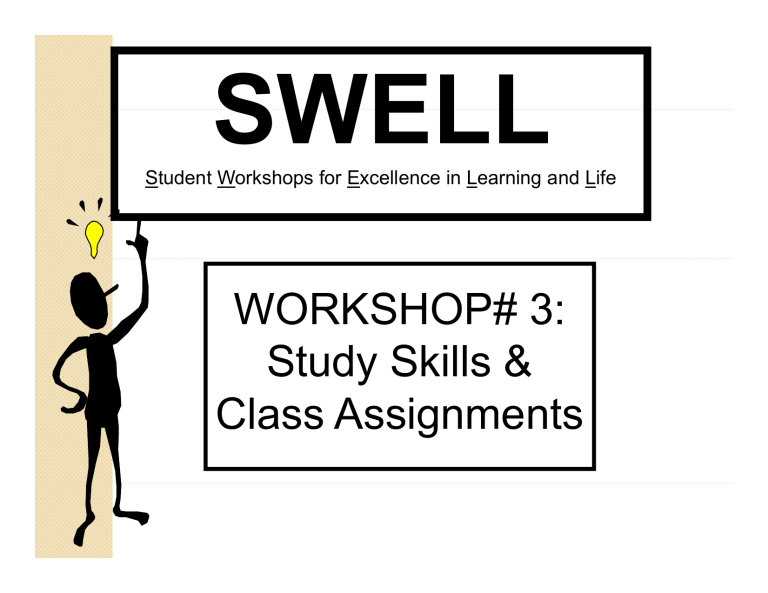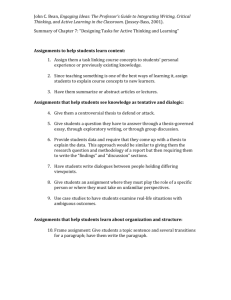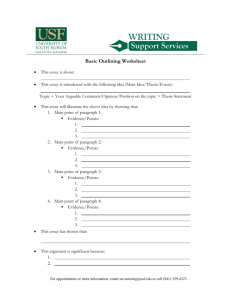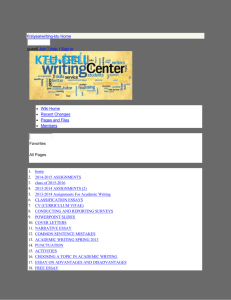SWELL
advertisement

SWELL Student Workshops for Excellence in Learning and Life WORKSHOP# 3: Study Skills & Class Assignments SELF-ASSESSMENT— SELFASSESSMENT—STUDY SKILLS AND CLASS ASSIGNMENTS 1. ___ Before I start an assignment, I read the guidelines in the syllabus and, if applicable, I download any additional information posted on the professor’s website. 2. ___ I skim or ‘preview’ a chapter before I begin to read. 3. ___ I wait to underline, highlight, or annotate the text until after I read a page or section. 4 4. ___ I take notes while I read read. 5. ___ I know how to use the WIU Library website to find research and suggested readings assigned by my teacher. 6. ___ I look for connections between a textbook and class lectures or discussions. 7. ___ I set goals for each study period and take a short break when I have reached my goal. 8. ___ I belong b l tto a study t d group for f each h off my classes, l and d we meett often ft to t go over our notes and prepare for exams. 9. ___ When writing research projects, my main source of information is from the internet. 10. ___ I have a plan and timeline set out before I start researching or writing papers or completing assignments. SQ3R - A STUDY/READING SYSTEM SURVEY – Gather the information necessary to focus and formulate I. your goals i. State your purpose for reading the material. ii. Read the title – help your mind prepare to receive the subject at hand. iii iii. R d th Read the iintroduction t d ti and/or d/ summary – pick i k outt the th chapter’s h t ’ main i points. i t iv. Notice each boldface heading and subheadings – organize your mind before you begin to read and build a structure for the thoughts and details to come. v. Skim over graphs, tables, charts, etc. to see how they support and explain the text. QUESTION – Help p your y mind engage g g and concentrate II. i. Frame questions – perhaps variations of the headings, sub-headings, or topic sentences, which you make into your personal questions. READ – read d actively ti l to t answer your questions ti and d to t fulfill f lfill your III. purpose i. Set realistic time goals and number of pages to read. ii. Divide chapter into small sections. iii. Ask yourself a question before you start to read. iv. Take breaks. v. Use your hand and highlighter to pull your eyes down the page, marking only the essential words and phrases. vi. Think, interpret and analyze the first time you read, to avoid unnecessary re-reading. RECITE - retain your mind to concentrate and learn as it reads IV. i. After each section - stop, look away from the book, recall your questions, and see if you can answer them from memory. ii. If not, look back again, but do not go on to the next section until you can recite the answers. iii. Also, try to visualize what you have just read. iv. p notes or outlines of what yyou have read. Make separate REVIEW – refine your mental organization and begin building V. memory. i.i Once you have completed the whole chapter: i. Reread your outline, look away, and recite the outline from memory. ii. Go back over all your questions. iii. Continue this p process until yyou feel that yyou understand and know the material. iv. Take a short break and reward your success. v. Decide when you are ready to work again, center your thoughts, take a few minutes to review the information you just learned, and go on to the next chapter or another subject. Reading Texts y Scan the chapter first. y Read the first sentence of every paragraph more carefully than the rest of the paragraph. ◦ Take notes on headings and first sentence of each paragraph before reading the chapter itself. ◦ Focus on nouns and main propositions in each sentence. ◦ For Example: Classical conditioning is learning that takes place when we come to associate two stimuli in the environment. One of these stimuli triggers a reflexive response. The second stimulus is originally neutral with ith respectt to t that th t response, but b t after ft it has h been b paired i d with ith the th first fi t stimulus, ti l it comes to t trigger ti the th response in its own right. Classical conditioning = learning = associating two stimuli 1st stimulus triggers a response 2nd stimulus = originally neutral, but paired with 1st --> triggers response. Reading Critically Ask yourself the following questions as you read: y What is the topic of the book or article? What issues are addressed? y What conclusion does the author reach about the issue(s)? y What are the author's reasons for his or her statements or belief? Is the author using facts, facts theory or faith? y ◦ Facts can be proven ◦ Theory is to be proved and should not be confused with fact ◦ Opinions may or may not be based on sound reasoning. Faith is not subject to proof by its nature t Has the author used neutral words or emotional words? Critical readers look beyond the language to see if the reasons are clear y Be aware of why you do, or do not, accept arguments of the author Memory Techniques Organize 1. Learn from the g general to the specific. p 2. Make it meaningful and relevant to you. 3. a) What do you want from the information? b) How does this information relate to your goals? c) The answers to these questions make it relevant to you. Create associations. Try to link each new piece of information with something you already know. Use your body 4. Learn it actively. Reinforce the words with action. Stand up, sit up straight, pace back and forth, and/or gesture with your hands to get your body involved when you study. 5. Relax. It is easier to learn when you are not stressed and tense. 6. Be artistic. Draw pictures, charts or cartoons to connect facts. 7. Recite and repeat. Audible repetition uses both your physical and auditory senses, which accelerate your learning ability. Hearing the information as you recite in your own words increases your ability to remember. 8. Write it down. Writing, or typing, is active learning. Writing requires you to be logical and reveals missing information. Try re-reading your notes out loud. Use your brain 9. Keep distractions down. 10. Over learn. 11. Escape the short-term memory trap. Make sure everything you learned is in long-term memory by reviewing until you have over learned. 12. Use daylight. Try studying difficult subjects during the daylight hours when your concentration is more effective. 13. Distribute the learning. 14. Be aware of attitudes. 15. Choose what not to remember. Be selective. Decide what is essential, and apply memory techniques to those ideas. 16 16. Combine memory techniques. techniques Memory techniques work better in combination. Recall 17. Remember something else. Brainstorming is a technique used to promote recall. 18. Notice when you do remember. Everyone learns and remembers differently. Pay attention to the styles that work for you. 19. Use it before you lose it. Practice using information regularly – read it, write it, speak it, listen to it or apply it. The more you use information, the greater the recall. 20. Remember that you never forget. Properly stored information is never lost, though you might have problems recalling it. KNOWING HOW YOU STUDY y Everyone is different y Space out your studying – review class materials at least several times a week y Have all of your study material in front of you y Start out by studying the most important information y Take short breaks frequently y Make sure that you understand the material well y If you choose to study in a group, only study with others who are serious about the test. y Test yourself or have someone test you on the material to find out what your weak and strong areas are. Control Your Study Environment 1. Set aside a fixed place for study and nothing but study. 2. Before you begin, write down on a sheet of paper the time you expect to finish. Keep a record of your goal setting setting. 3. Strengthen your ability to concentrate by selecting a social symbol that is related to study. 4. If your mind wanders, stand up and face away from your books. 5. Stop at the end of each page, and count to 10 slowly when you are reading. 6. Set aside a certain time to begin g studying. y g 7. Do not start any unfinished business just before the time to start studying. 8. Set small, short-range goals for yourself. Divide your assignment into subsections. 9. Keep a reminder pad. Another trick that helps increase your ability to concentrate is to keep pencil and paper by your notebook. If while you are studying, you happen to think about something that needs to get done, jot it down. 10. Relax completely before you start to study. RESEARCH & WRITING STEPSTEP-BYBY-STEP Step 1 - Getting Started Goal: Preparing for the assignment and getting ready to choose a topic. Understand the assignment I. I. 3 Kinds of Research Assignments I. II II. III. Report – This type of research paper is really a form of individual study. The measure of success is how well the student can conduct research, analyze and organize the information and communicate it clearly in written form. Issue Analysis – A research paper may highlight a particular issue or problem in a field of study study. The paper may focus on analysis of the issue and its solutions, possibly from both historical and current perspectives. The posture of the writer is frequently that of a neutral observer more than an advocate for a particular position. Advocacy or Persuasion – A research paper may involve taking a stand on an issue and defending it against opposing points of view view. The student will research the issues and read others' arguments for and against. The paper will anticipate and deflect arguments against the position, while presenting supporting evidence in favor of the position. II. Consider the process you will use III. Set yyour deadlines for each step p of the assignment g IV. Think about possible topics V. Info search – browse, read, relax VI. Relate your prior experience and learning VII. Jot down your questions and ideas about possible topics Step 2 – Discovering and Choosing a Topic I. Info search – read for overview of various topics II. Continue thinking and jotting down questions and ideas in your notebook III. Info survey – what print and electronic resources are available IV. Try different topics on for "size“ Step 3 - Looking for and Forming a Focus Goal: Exploring your topic, and finding and forming a focus for your research. I. Info search – exploring your topic II. Info search – preliminary notetaking III. Choosing a focus or combining themes to form a focus Step 4 - Gathering Information Goal: Gathering information which clarifies and supports your focus focus. I. Info search – finding, collecting and recording II. Think about clarifying or refining your focus III. Start organizing your notes IV. Think about what your thesis statement will be Step 5 - Preparing to Write Goal: Analyzing and organizing your information information, and forming a thesis statement. I. Analyze and organize your information II. Construct a thesis statement III. Weed out irrelevant information IV. I f search Info h – fill iin th the gaps Step p 6 - Writing g the Paper p Goal: Writing, revising and finalizing the paper. I. Think about the assignment, the audience and the purpose II. Prepare an outline III. Write the rough draft IV. Know how to use your source materials and cite them V. Have others read and critique the paper VI VI. Revise and proofread RESEARCHING ON THE INTERNET y Narrow your topic and its description; pull out key words and categories y Use a search engine: does it contain a directory of topics? Find the best combination of keywords to locate information you need; enter these in the search engine y G t assistance Get i t from f your local l l research h lib librarian i y Refer to known, recommended experts or reviewed web sites y Refer to professional portals that may have directories or collections by topic y Review the number of options returned. If there are too many web sites, add more keywords. If there are too few options, narrow/delete some keywords, or substitute other keywords y Review the first pages returned: If these are not helpful helpful, review your key words for a better description 9 Cs for Evaluating Internet Sources 1. Content What is the intent of the content? Are the title and author identified? Is the content "juried"? Is the content "popular" or "scholarly”? What is the date of the document or article? 2. Credibility Is the author identifiable and reliable? Is the content credible? Authoritative? What is the purpose of the information? Is the URL extension: .edu, .com, .gov or .org? 3. Critical C iti l Thi Thinking ki H How can you apply l critical iti l thi thinking ki skills, kill iincluding l di previous knowledge and experience, to evaluate internet resources? Can you identify the author, publisher, edition, etc. as you would with a "traditionally" published resource? 4. Copyright Even if the copyright notice © does not appear prominently, the material falls under the copyright conventions. "Fair use" applies to short, cited excerpts, usually as an example for commentary or research. Materials are in the "public p domain" if this is explicitly p y stated. 5. Citation Internet resources should be cited to identify sources used, both to give credit to the author and to provide the reader with avenues for further research. 6 6. Continuity Will the internet site be maintained and updated? Is it now and will it continue to be free? Can you rely on this source over time to provide up-to-date information? Some good .edu sites have moved to .com, with possible cost implications. 7 7. Censorship Is your discussion list "moderated"? What does this mean? Does your search engine or index look for all words or are some words excluded? Is this censorship? 8. Comparability Does the internet resource have an identified comparable print or CD ROM data set or source? Does it contain comparable and complete information? Can you identify sources for comparable earlier or later data? 9. 9 Co te t What Context at iss the t e context co te t for o your you research? esea c Can Ca you find d "anything" a yt g o on your topic, that is, commentary, opinion, narrative or statistics and your quest will be satisfied? Are you looking for current or historical information? Definitions? Research studies or articles? How does internet information fit in the overall information context of yyour subject? j Before yyou start searching, define the research context and research needs, and decide what sources are best to use to successfully fill information needs without data overload. Learning Through Writing y Writing helps clarify your thinking; You do not really know what you think until you write it y Writing on a regular basis makes you a better writer; Like anything else, the more you practice, the better you get y Deadlines can be helpful; They can give you the energy and concentration you need to write y Length limits are good for your style; Eliminating wordiness improves your emphasis and impact y Good writing is edited writing; You never outgrow your need for a good editor y Letting your first draft "rest," will help you edit it more effectively; Certain problems become obvious if you allow time to pass between drafting and editing y Some stages of writing are inefficient and sloppy; Accepting p g the imperfection p of the first draft is a wonderful freedom y Making it fun keeps it fresh; As with most things, a column on business writing does not have to be dry and boring y Writing W iti counts; t Writing is a reflection of your personality and style, a statement of your professional standards. It counts as much as anything else you do REVISION GUIDELINES Organization y Is there a clear introduction, body and conclusion? y Does the introduction provide sufficient background for the reader? Are the "who," "where," "why," "what," and "how" questions addressed? y Is there a thesis sentence? Is the purpose of the essay clear? y Does the essay move from general to specific? y Are there sufficient transitions between related ideas? y Is the overall organization murky or clean? In other words, does the t e writer te a avoid o d introducing t oduc g new e material ate a in tthe e conclusion or switching subjects in the middle of a paragraph in the body? y Does every paragraph address the subject matter of the thesis in some way? Content and Style y Does the essay show that you have a knowledge of the audience? y Is the length appropriate and adequate? y Have you used sufficient examples and detail to make your points clearly? y Has the assignment been addressed? y Is the tone of the essay appropriate? y Have you avoided insulting the reader? y Is the tone of the essay professional and appropriate? y Is the language convincing, clear, and concise? y Have you used fresh language and a creative approach? Research and Sources y Are all sources credible? y Is the research accurate, unbiased and complete? y Have you fully interpreted the findings? y Have you commented on each source used? y Is the analysis y based on hard evidence? y Is the analysis free of faulty reasoning? y Have all quotations been checked against the original? y Are all quotations introduced? Is the flow of the essay seamless? y If material was paraphrased, are the sources still mentioned? y If included, are recommendations based on accurate interpretations? y Have all facts been checked for accuracy? y H Have any potentially t ti ll lib libelous l statements t t t b been eliminated? li i t d? Proofreading y Have you checked grammar and punctuation? y Have you spell checked the essay? y H Have you checked h k d ffor any particular i l patterns off error? ? y Are the page numbers correct? y Is the title capitalized correctly? y Have you used the correct margin and font? Goals to Improve Study Habits & Completing Class Assignments g How will you become more diligent in studying and completing class assignments this semester? HINT: Think back to your initial self-assessment! self assessment! • • • • • • • ___________________ ___________________ ___________________ ___________________ ___________________ ___________________ ___________________ Student Workshops for Excellence in Learning and Life Completion of Workshop! Congratulations! You have completed the third workshop – “Study Skills & Class Assignments" Print out your certificate and sign and date it. Bring the certificate to your meeting with your advisor so you can discuss the strategies covered in the workshop. workshop



![Submission 68 [doc]](http://s3.studylib.net/store/data/008000926_1-fed8eecce2c352250fd5345b7293db49-300x300.png)

